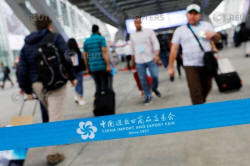Unwelcome guest: U.S. tariffs loom at China's biggest
trade fair
 Send a link to a friend
Send a link to a friend
 [October 12, 2018]
By Ryan Woo [October 12, 2018]
By Ryan Woo
BEIJING (Reuters) - Amid gathering gloom
over the state of the Chinese economy, exporters of motorcycles,
tractors, photocopiers and Christmas tree lighting will join thousands
of other companies peddling their wares at China's largest trade fair
Monday.
Many of those exporters will have something in common - uncertainty over
future U.S. orders as a trade war with the United States rages. The
turmoil has added to concerns over the health of the Chinese economy,
already under pressure from a cooling property market, a crackdown on
corporate debt and risky lending practices, and a nationwide
anti-pollution campaign.
The United States over the summer levied tariffs of up to 25 percent on
$250 billion of Chinese goods as punishment for what it says are unfair
trade practices by China. The latest tariff salvo represented half of
the $500 billion of products that the United States bought from China
last year.
The rapid escalation of the trade dispute has taken many Chinese
exporters by surprise. At the spring session of the twice-a-year Canton
Fair in Guangzhou, only a quarter of the exporters whom Reuters spoke to
said they expected a full-blown trade war.

As exporters gather at the autumn session of the three-week gathering
that starts Monday, a far more somber outlook is expected to pervade the
tens of thousands of exhibition booths at the fair.
U.S. President Donald Trump has repeatedly threatened to slap tariffs on
more Chinese imports in an intensifying trade war that has led many
forecasters, including the International Monetary Fund, to cut their
global economic projections for 2018 and 2019.
Beijing has been urging Chinese exporters to diversify their overseas
destinations and rely less on the United States - China's biggest
trading partner - or turn their focus to domestic customers instead.
"Our existing U.S. orders are relatively stable, but our U.S. clients
are not increasing their orders," said an official at a Guangzhou-based
battery maker, one of many facing higher U.S. tariffs on Chinese
batteries.
"We're keeping prices stable and swallowing the tariffs ourselves," the
official said.
As export-reliant cities and provinces like Guangdong show the strain,
policymakers are increasingly rolling out measures to help businesses
weather the trade storm.
The central bank has cut the amount of cash that commercial banks need
to set aside as reserves four times this year to spur lending to small
businesses. The finance ministry has reduced taxes and increased tax
rebates to help lower the overheads of businesses. Billion-dollar
infrastructure projects have been put on the fast track to stimulate
growth.
The authorities, while saying they will not resort to competitive
devaluation of China's currency to boost exports, have allowed the yuan
<CNY=CFXS> to fall about 6 percent against the dollar this year.

Overall Chinese exports have been mostly resilient, with data Friday
showing that September shipments soared 14.5 percent year-on-year, far
exceeding expectations for an 8.9 percent uptick.
SLOWING ECONOMY
The trade war with the United States is complicating an already
weakening picture of growth in China this year. Beijing has set a GDP
growth target of around 6.5 percent for 2018. The economy expanded 6.9
percent last year.
[to top of second column] |

Visitors attend the China Import and Export Fair, also known as
Canton Fair, in the southern city of Guangzhou, China April 16,
2018. REUTERS/Tyrone Siu/File Photo

Growth has been slowing as China sheds excess production capacity and shuts
polluting factories, with fixed asset investment slumping this year and monthly
industrial output growth stuck in a relatively low range of 6-7 percent.
Meanwhile, curbs and restrictions put in place to fend off property speculators
have resulted in a slowdown in the residential real estate market, hitting
construction and other related sectors.
The impact of a multi-year crackdown on corporate debt levels and risky lending
practices has also become more apparent. Private firms are warning about tighter
financing as their access to shadow financing - a cheaper source of funds than
bank loans - shrinks.
Annual growth in outstanding total social financing, a broad gauge of credit
that includes off-balance sheet financing, slowed to 10.1 percent in August, the
lowest on record.
As businesses struggle or even go belly-up, domestic consumption, a driver of
the economy, has started to moderate.
Monthly growth in retail sales, one gauge of China's consumption, dipped below
10 percent in April where they have remained since. The last time retail sales
grew less than 10 percent was over a decade ago.
Automobile sales fell for the third straight month in September, down 11.6
percent from a year earlier, as worries about the economy prompted consumers to
tighten their purse-strings and forego big-ticket purchases.

WAIT-AND-SEE
The state-controlled media has so far played up China's capability to tackle
both internal and external challenges, including the trade war, saying there are
ample policy tools available to keep growth on an even footing.
"The impact of the trade war is not too obvious yet because the U.S. tariffs
have not filtered down to some sectors yet," said Joe Chung, owner of a ceramic
tile manufacturer in Guangdong.
"The worry is not just about the United States. With exports to the U.S.
slowing, there will be increased competition for other overseas markets," Chung
said, predicting tough times over the next two years.
Ceramic floor materials are on the U.S. tariff hit-list.
Chinese exporters of goods not yet on any U.S. tariff retaliation list vary,
including products like toys, sewing machines and wigs.
China's foreign trade growth may slow in the fourth quarter, the country's
customs agency said on Friday.
(Reporting by Ryan Woo; Additional reporting by Stella Qiu in BEIJING and
Shanghai Newsroom; Editing by Philip McClellan)
[© 2018 Thomson Reuters. All rights
reserved.] Copyright 2018 Reuters. All rights reserved. This material may not be published,
broadcast, rewritten or redistributed.
Thompson Reuters is solely responsible for this content. |